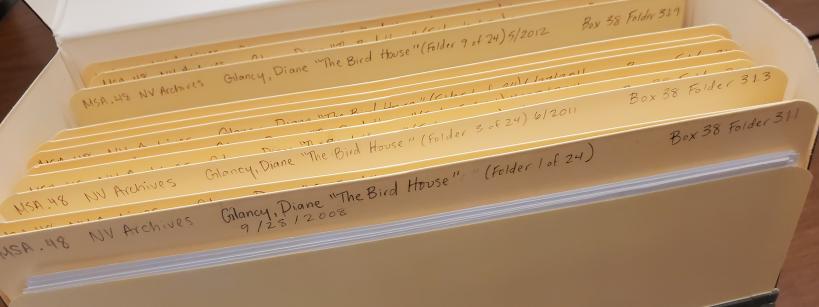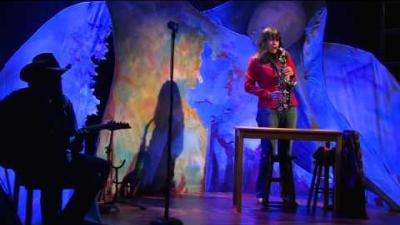By Victoria Bernal, Women in the Archives Social Media Manager
The rich archive of the Native Voices theatre company reflects 26 years of Native storytelling in which women’s stories always played a prominent role. As the only Equity theater company in America devoted exclusively to developing and producing new theatre works by Native American, Alaska Native, Native Hawaiian, and First Nations playwrights, Native Voices was co-founded by Randy Reinholz (Choctaw) and Jean Bruce Scott and moved to the Autry in 1999. “Native Voices was an early adopter of producing female playwrights. We’ve always had something close to a 50-50 gender equity of productions,” Randy Reinholz. The Autry’s head archivist Liza Poses explained, “There’s nothing like Native Voices anywhere, which makes its archive inherently unique, especially when considering the mass amount of material saved by the co-founders Randy Reinholz and Jean Bruce Scott.”
These women’s stories can be found in the scripts, research material, production notes, programs, budgets, publicity announcements, contracts, A/V material, and photos in the archive of the country’s longest running Native theater company working under an Equity contract. When thumbing through the archive files, one realizes the depth and complexity of these playwrights’ creative process. For instance, Diane Glancy’s (Cherokee) scripts in the archive include innumerable handwritten notes scribbled on the drafts of her plays. The work of recent MacArthur Fellow Larissa Fasthorse (Sicangu Nation) reveals her development as a writer when looking back at her 2008 play Teaching Disco Square Dancing to Our Elders: A Class Presentation. Arigon Starr’s (Kickapoo, Creek) scripts illustrate how a songwriter transforms into a playwright as her creative process centers the songs within her storytelling. In reviewing the works of poets Diane Glancy, Marie Clements (Metis) and Joy Harjo (Creek), one sees a poet’s language transform into a performance—how a poem grows into a one-person play, then into a multi-character play, and finally into a theatre production.
“These playwrights put so much of their daily lives into the pursuit of their particular stories,” Jean Bruce Scott explained as she spoke about the cost of this creative work on these women writers. For instance, playwright and Native Voices Artistic Director DeLanna Studi (Cherokee) spent six weeks retracing the path of her great-great grandparents along the Trail of Tears with her father. Studi held workshops and storytelling circles in partnership with community organizations along the way. She transformed that personal journey with her ancestors into And So We Walked: An Artist’s Journey Along the Trail of Tears, a one-woman play that has been performed on stages around the country. Studi hopes that future researchers looking through these archives will gain a deeper understanding of the beauty and complexity of Native storytelling. “A lot of people want us to tell our stories in this Western canon and that’s not how we tell stories. The way we tell our stories is not valued as high as the way non-Native playwrights tell their stories,” Studi.
The women playwrights also found inspiration in the Autry’s archive and collections, and in some cases, physical museum spaces. Diane Glancy created the play Salvage after seeing the Autry’s collection of barbed wire on a behind-the-scenes tour. The Autry’s archive about Indian boarding schools was part of the research for the Native Voices Artists Ensemble’s production of Stories from the Indian Boarding School. In an archived video interview, playwright Marie Clements described the inspiration she found in the Autry’s large collection of Native American baskets, likening a woman’s process of weaving a bowl to a writer collecting stories for the stage. After spending time with the Indian dioramas in the tunnel of the Southwest Museum, Clements situated the stories of three present-day sisters behind life-size diorama glass for her play Tombs of the Vanishing Indian. In discussing the broader idea of how playwrights are informed by stories found in the archive, Jean Bruce Scott emphasized, “research librarians and archivists play an important part of the creative process for playwrights.”
While the archive features the work of theatre notables like DeLanna Studi (photographed on the 2018 cover of American Theatre magazine), US Poet Laureate and playwright Joy Harjo, and MacArthur Fellow Larissa Fasthorse, the focus of Native Voices is less on a hierarchy determined by the media spotlight and more on developing the breadth and depth of the undeniable talent pool of Native playwrights, directors and actors. The women’s stories in the Native Voices archive has created a rich source for journalists and historians, as well as theatre producers looking for Native stories. One additional hope for the archival materials is that other BIPOC companies and producers can learn from the Native Voices process to adopt the parts that might work for them and improve on the company’s efforts to continue to build an American theatre that looks more like America. Preserving these plays in the archive, along with Native Voices’ unique process, ensures future generations can build upon the work of those women who came before them.
Below is a list of Native Voices productions of plays written by women from 1999–2019. These plays were performed at the Autry Museum as well as other stages across the world.
Pure Native by Vickie Ramirez (Tuscarora)
Autry Museum, 2019
The Smithsonian National Museum of the American Indian in Washington D.C., 2020 (delayed due to COVID)
Fairly Traceable Mary Kathryn Nagle (Cherokee)
Autry Museum, 2017
Idyllwild Arts Academy, 2019
Stories from the Indian Boarding School by The Native Voices Artists Ensemble
Presented at colleges and universities throughout the state of California 2016, 2017 and 2018
NDNZ in a Box, three one-acts for the Hollywood Fringe Festival, 2015. Includes There Is No “I” In NDN by Jennifer Bobiwash (Ojibway) and Stories from the Indian Boarding School by The Native Voices Ensemble
Stand-Off at Hwy 37 by Vickie Ramirez (Tuscarora)
Autry Museum, 2014
University of South Dakota, 2015
Birdhouse by Diane Glancy (Cherokee)
Autry Museum, 2013
Cikiuteklluku: Giving Something Away by Holly Stanton (Yupik)
Produced by Perseverance Theatre and Out North Performing Arts in association with Alaska Native Heritage Center and Native Voices at the Autry, Anchorage, Alaska, 2012
The Frybread Queen by Carolyn Dunn (Cherokee, Creek, Seminole)
Montana Repertory Theatre, Missoula, Montana, 2010
Autry Museum, 2011
Carbon Black by Terry Gomez (Comanche)
Autry Museum, 2009
Wings of Night Sky, Wings of Morning Light by Joy Harjo (Creek)
Autry Museum, 2009
Alaska Heritage Center, Anchorage, Alaska, 2010
Joe’s Pub @ The Public Theatre, New York, 2010
La Jolla Playhouse, San Diego, California, 2010
Merrimack College, North Andover, Massachusetts, 2010
Outpost Performance Space, Albuquerque, New Mexico, 2010
First Nations House of Learning, University of British Columbia Vancouver, BC, Canada, 2012
Salvage by Diane Glancy (Cherokee)
Autry Museum, 2008
Origins Festival, Riverside Theatres, London, England, 2009
Teaching Disco Square Dancing to Our Elders: A Class Presentation
by Larissa Fasthorse (Sicangu Nation)
Autry Museum, 2008
The Red Road by Arigon Starr (Kickapoo, Creek)
Autry Museum, 2006
The Smithsonian National Museum of the American Indian in Washington, D.C., 2006
The Smithsonian National Museum of the American Indian in New York, 2006
The Cherokee Casino, Tulsa, Oklahoma, 2006
Theatre of the World, San Diego, California, 2006
NPN Native American Performance Showcase, Cedar Rapids, Iowa, 2007
The Gilcrease Museum, Tulsa, Oklahoma, 2007
Queensland State Library, Brisbane, Australia, 2008
Idyllwild Arts American Indian celebration, Idyllwild, California, 2008
16th International Association of Theatre for Children and Young People (ASSITEJ) World Congress and Performing Arts Festival, Adelaide, Australia, 2008
Recorded as a radio play for Native Radio Theatre, 2009
Stone Heart by Diane Glancy (Cherokee)
Autry Museum, 2006
The Smithsonian National Museum of the American Indian in Washington D.C., 2006
The Smithsonian National Museum of the American Indian in New York, 2006
Jump Kiss by Diane Glancy (Cherokee)
Autry Museum, 2002
Urban Tattoo by Marie Clements (Metis)
Autry Museum (in conjunction with the exhibit "Powerful Images: Portrayals of Native America"), 1999
Aboriginal Voices Festival in Toronto, Ontario, 1999
The Glenbow Museum in Calgary, Alberta, 1999
New World Theatre in Amherst, MA, 2000
The University of Miami, Ohio, 2000
Native Radio Theatre Project, a collaboration between Native Voices and Native American Public Telecommunications, to support and produce audio / radio theatre.
Melba’s Medicine by Rose-Yvonne Colletta (Apache), 2006
Super Indian by Arigon Starr (Kickapoo, Creek), 2006 and 2007
The Best Place to Grow Pumpkins by Rhiana Yazzie (Navajo), 2006
Why Opossum’s Tail is Bare, by the Students at the Youth Academy of the Eastern Band of Cherokee, Cherokee, North Carolina, 2007
The Peach Seed by Rhiana Yazzie (Navajo), 2007
The Red Road by Arigon Starr (Kickapoo, Creek), 2009
Image above: Folders showing drafts of the play Birdhouse by Diane Glancy created from 2008–2013. Native Voices Institutional Archives, Autry Museum; MSA.48
Native Voices Interviews on YouTube

